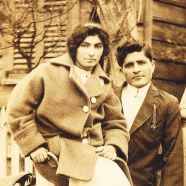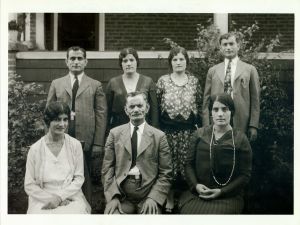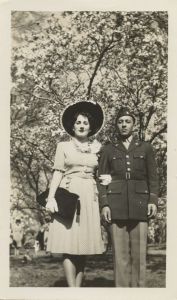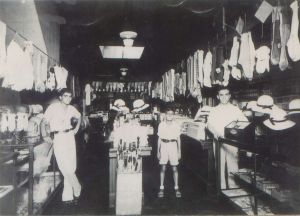
Zaytoun Family, 1914, Copyright © 2012 Khayrallah Program for Lebanese-American Studies, Department of History, North Carolina State University
Share This
Print This
Email This
Cedars in the Pines
When the image of Arab Americans is evoked, the vision that typically comes to mind is that of recent immigrants, Muslim, living in the Northeast or Detroit area. You rarely recognize them in your church-going Southern neighbors whose family store has been a Main Street fixture for three generations, whose great-uncle served alongside yours in World War II. This is the story of the cedars of Lebanon so firmly rooted in the soil of the native pines of the American South that only their names—like the eponymous Khoury Convention Center in Greensboro, North Carolina—attest to their origins.
The two-year project Cedars in the Pines: The Lebanese in North Carolina has been collecting oral histories, photos, music, home movies, letters, newspaper clippings, statistical data, naturalization records, and other material that collectively narrate the story of this community from its earliest days in the 1880s through today. Out of this continuing and geographically expanding research, the project has produced a documentary titled Cedars in the Pines that has been screened to large audiences across North Carolina over the past six months and was recently broadcast on WUNC TV. Additionally, this material has been digitized and made accessible to researchers and the general public through our online archive at http://nclebanese.org. The final stage of this initial phase will culminate in a museum exhibit that will travel across the state beginning in February 2014.

Mack Family, Copyright © 2012 Khayrallah Program for Lebanese-American Studies, Department of History, North Carolina State University
The story these sources tell is very different from the stereotype of the Arab in nineteenth-century Orientalist representations and Hollywood images. The image of the supposedly lascivious, murderous Arab arose in the guise of Barbary (North African) pirates and Moors who preyed on traveling Americans and was reinforced by subsequent depictions on the silver screen. In the notorious 1921 film The Sheikh, Rudolph Valentino utters the memorable line: “When an Arab sees a woman he wants, he takes her.” In the 1970s and thereafter, American popular culture added a new twist to these preexisting depictions: that of Arab as terrorist.
After the horrific attacks of September 11, 2011, as Jack Shaheen notes, “Series such as 24, The Unit, The Agency, NCIS, Sleeper Cell, Threat Matrix and Sue Thomas: F.B.Eye [and one may add Homeland] exploited post-9/11 fears pummeling home myths that made the profiling, imprisonment, extradition, torture and even death of these one-dimensional characters more palatable to the public.” The collective effect of these preponderant popular culture images has been the alienation of Arabs in mainstream narratives of American life and history.

Salem couple, Army uniform, Copyright © 2012 Khayrallah Program for Lebanese-American Studies, Department of History, North Carolina State University
Until recently, this was compounded by a conspicuous absence of countervailing narratives about the long history of Arab Americans as citizens of the United States who have lived in, built, and fought for this country over the past century and a half. Nowhere is this more glaringly apparent that in the American South. Though numerically less significant than its Northeastern counterparts, the community of Arab Americans in North Carolina (and the South in general) was nonetheless critical at two levels. First, their smaller numbers forced them to assimilate more rapidly while seeking to maintain elements of their heritage. Equally important is the role they played in reshaping the cultural, ethnic, and religious landscape of the state, as well as shifting its economy toward an industrial base that opened up the state to global connections, which helped reshape North Carolina into a more urbanized and cosmopolitan environment.
More significant than the raw numbers are the percentages that Arab Americans represented of the overall population. Although the population of Arab Americans in Massachusetts or New York was four- or five times the largest population in the South (Texas), Arab Americans in North Carolina represented almost 9 percent of all immigrants to the state, as compared to 0.4 percent of New York’s immigrant community. Today, there are more than 30,000 Arab Americans in North Carolina, and another half a million living in the South.
The pattern of early Arab immigration to North Carolina began with individuals traveling here as part of a larger peddling community radiating from “Little Syria” in New York. Riding the train to the eastern part of the state (Roanoke Rapids, New Bern, Goldsboro, Wilmington, etc.) or further west (Statesville and Charlotte), the earliest peddlers came to sell buttons, thread, needles, lace, and other sundry items out of their kashé (valise). Arriving in New Bern, Goldsboro, Raleigh, Burlington, or Charlotte, they walked into small towns and visited remote farmhouses, offering their wares and building relationships along the way. For those who excelled (and many despaired of this work), the reward was the accumulation of enough capital to buy a dry goods store in one of the textile mill towns in North Carolina. The Macks opened their store in Mooresville, and the Hatems moved to Roanoke Rapids. Others opened gas stations, clothing stores, or restaurants. Regardless of the nature of their business, the whole family worked, including children as soon as they were tall enough to reach the cash register. As the first generation established itself financially, its members parlayed their success into investment in the education of their children, who enrolled in universities to become engineers, doctors, and lawyers. This was meant not only to secure jobs but to attain middle-class respectability and gain entrance into the mainstream Southern society.

Kannan Family General Store, Copyright © 2012 Khayrallah Program for Lebanese-American Studies, Department of History, North Carolina State University
This desire for acceptance was partially borne out of a racialized environment that sometimes met them with indifference but more frequently exposed them to open hostility, as with other ethnic immigrant communities around the country. As one Wilmington newspaper wrote of the community in 1897: “These foreigners are not a credit to a community by any means; filthy and immoral in their habits, breeding pestilence and filth wherever they live, it is indeed to be regretted that Wilmington should ever be subjected to these pests.” Another newspaper item described the rough treatment meted out to “the Syrians,” as they were known in North Carolina. It noted that “their language was mocked, stones thrown at them, etc.”
The community in North Carolina and the South challenged these attacks directly at times. Hikel (Haykal) Gideon wrote defending himself against the charge of “filth” and “immoral breeding,” and noted, “I and all others who are not American Indians deprecate your injudicious fling at foreigners.” Joseph Salem recalled getting into many altercations in his high school in New Bern to defend himself and his siblings against verbal attacks on their “foreignness.” Thus, as newcomers and predominantly Catholic or Greek Orthodox Christians, these early immigrants faced an inhospitable environment that forced them to keep their Arab identity private within their homes and assimilate. Nonetheless, they maintained a sense of heritage and distinct identity through family, church, community, and food. This ethnic consciousness remained, albeit in its waning stages, well into the 1960s when the second wave of Arab immigrants began to arrive in South.
This latter wave of immigrants embodied different characteristics. From the 1960s on, as many Muslims as Christians came to the South, and they came here from a broader swath of the Middle East. Moreover, a significant proportion came with university degrees and sought higher education that allowed them quicker entry into the ranks of the middle class. This marked shift accounts for the fact that, on average, Arab Americans hold more and higher degrees than the average in the United States, and their income surpasses the median for the country. Additionally, their later arrival coincided with the rise of larger political consciousness of “Arabness” across the Middle East, and its concomitant Arab American ethnic identity in the United States. Hence, even as prejudice against Arabs in America became more overt and pervasive in the second half of the twentieth century, the community at large became more vocal in asserting its identity, as manifested in the plethora of Middle Eastern restaurants, foods, cultural events, and community groups that have spread across the South. Arab and Arab American music, film, and literature are also weaving visible threads into the tapestry of Southern American culture. Cedars in the Pines contributes to this trend by highlighting the integral and constructive role of Arab Americans in the South’s history, present, and future.






